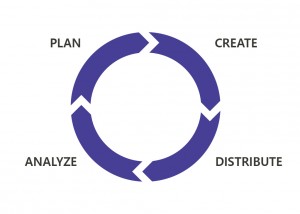Content Marketing is known for being really accessible (everyone can do it, registering a domain name for a self hosted wordpress blog is cheap) and can be quite effective if you do it properly, with a purpose and with associated metrics. However, content marketing faces one big issue : it takes a lot of time.
In this post, we’ll try to address the following question : How can a writer track time when working on a blog ? A quick search on Google didn’t bring much material to answer, so I decided to go for the creative approach. I’ll try to define some processes that might be efficient for this task, and to list some associated tools.
This blog post might be read as an introduction to this issue. I will really be happy to provide more advanced tips in the future.
Lack of time
I guess that I don’t need to convince you about the fact that implementing a content strategy takes a lot of time, but just in case : Content Marketing Institute publishes Content Marketing State – Yearly reports about the state of this marketing field. In the 2015 report, the major challenge people admitted to face was the lack of time (in B2B and B2C areas).

What does “lack of time” really mean ? It means that you are not really aware of the time you have to invest in planned (and unplanned) actions, and more than that, it means that you under estimate each task completion time.
Tracking time will allow you to have a better estimate of your work abilities. This will be the start for an improvement. It’ll give you a tangible metric to focus on when learning and discovering new techniques. Over time you will probably not need it anymore, but whenever you are trying a new content channel, a new distribution media or even if you start writing about a new topic, getting to know completion times will help you a lot to get organized.
For instance, don’t plan on writing more than 3 or 4 blog posts a week if you need one full day for research and writing.
Define your Content Marketing Value Chain
In content marketing, many many tasks can be listed. For instance : finding an idea, researching about facts, writing, looking for illustrations, coming up with an appealing title, distributing on social networks … At Elokenz, we’ve decided to keep only four categories in our content marketing value chain : Plan, Create, Distribute, Analyze.

So, whenever we do something, we know it goes in only one of the four categories. It helps to define where starts and where ends a task. We don’t want to be overwhelmed under a dozen of separate tasks. We preferred to go for the simplest option, and to merge several small actions into bigger categories.
Time Tracking for Content Marketing
Our method to continuously reduce time
The first blog posts will allow us to get an estimate of the time we need to complete each task. For instance, at the moment, I am staying in the “creation” part of the quadrant and I already have spent three hours. When you are done with one post, open a spread sheet and note down the time you dedicated to the task.
I created one page for each category of our blog (content marketing and startup life), and tried to jot down the last posts in there. I also wanted to know the total time per post, and per task so I added an extra column and an extra row.
![]()
My idea is to improve one task at a time. I don’t have a lot of hindsight yet, but I have the feeling that I am either not tracking correctly time related to planning and analysis, or that these categories are not worth improving at this time. But I will wait to have 5 or 6 blog posts, so that the numbers make more sense.
Iterative improvement
Once you are more confident about the average time each macro task requires, pick the one that could be improved with least efforts (you are the best judge for that since you know your own weaknesses). Try to define 3 to 6 sub tasks and create a new spreadsheet. From there, continue your efforts in writing down the time you used for the macro tasks, but now, you should also write down the time you used for every sub tasks.

From the picture above I will get ideas on how to improve my workflow. Suppose that spending 30 minutes in average to find images for each post is too much for me. I might decide to spend one or two hours to bookmark a few stock websites so that I always have a good spot to find images. I can also try to create a collection with “potential images” on Pinterest and whenever I find a great image on the web, I store it, just in case a future article might be related. Or I could also hire someone on fivver or mechanical turk, to do this job for me (give them few instructions and ask them to find inspirational pictures) … and so on and so on.

The point is to find out tasks that you can improve, and to try your new ideas in a consistent experimental process. Once you find a way to improve your workflow, then, come back to the content value chain and try to tackle a new quadrant.
Some tools to track time
This method might seem long and painful, but with the right tools in hand, you’ll manage to track down your times more easily. Many time tracking tools exist out there, and I will publish another post pretty soon to give you few tips about how to chose one (depending on your status : freelancer, blogger, content manager, …).
Time tracking tools do several things. With the majority of them, you have to configure projects you are working on, and the the tool will track the time you spend on various apps, or URLs. Some tools even record screenshots (if you need to check that your employees are working on what the say they are). The main difference comes from the UI and the reporting dashboard between all these tools.
Here is a quick list of tools I’ve heard about so far :
- For individuals : Desktime , RescueTime, Toggl,
- For teams : Hubstaff, BillQuick, WorkPuls
- Incentive to track time : Time Doctor
Some have terrible UIs, some are really great. Here is a demo of DeskTime that I started to use while writing this article :

The experiment starts today
So, at Elokenz, the Time Tracking for our Content Marketing efforts starts today. We will post tips and updates as we’ll learn about how to do it more efficiently. The main two questions we are interested in are :
- How to improve the time of a single writer ?
- How to manage a writing team more efficiently ?
By leveraging both aspects, we are confident that a company can cut the time it dedicates to content marketing by 25% to 50%.
So, let us know if you also track time when doing Content or Inbound Marketing. We will be happy to share your experience on the blog.




